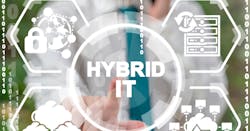Hybrid Computing is Helping Redefine Modern IT Models
This launches a new special report series , sponsored by Panduit, that explores the ins and outs of hybrid IT and how it is moving and forward and evolving modern IT models. Read on to learn how hybrid computing is changing the colocation and data center industry as we know it.
Get the full report.
It’s an exciting time to be a part of the digital world. Data centers are supporting some of the most advanced use-cases, working with data-driven solutions, new types of applications and services, and incorporating emerging technologies like AI and machine learning.
Hybrid is quickly becoming the new normal for those organizations striving to get ahead. But before you immediately think that this means ‘hybrid cloud,’ the concept of a Hybrid IT environment is a bit higher level. This means you’re leveraging more business and technology solutions to create more efficient environments and better competitive advantages. This is why Gartner predicts that in 2020, 90 percent of organizations will adopt hybrid infrastructure management capabilities.
But going hybrid is challenging. Getting Hybrid IT right means working with the right toolsets and the right partners to deploy your environment. As amazing as hybrid can be, you can run into complexity when it’s not done right.
“Organizations that adopt hybrid infrastructure technology will optimize costs and increase efficiency. However, it increases the complexity of selecting the right toolset to deliver end-to-end services in a multi-sourced environment.” – DD Mishra, research director at Gartner
Working with Hybrid, IT can change the way you deliver critical resources. It can help you design an underlying data center ecosystem that’s much more robust and efficient. A recent IDC report found that Hybrid IT allows companies with an on-premises and multi-cloud approach to optimize cost and application performance. Furthermore, it’s not only the data center and IT personnel that benefit from a flexible Hybrid IT platform. DevOps and application development teams also benefit.
The IDC report found that Hybrid IT serves as a continuous DevOps platform by providing a shared pool of application program interfaces (APIs) for both on and off-premise resources. In particular, it allows developers and operations teams (DevOps) to dedicate their time to application deployment and delivery rather than infrastructure management.
There are other unique benefits and use-cases as well. But, before we dive even further into Hybrid IT and the underlying ecosystem that supports it all, it’s crucial to take a step back and understand where Hybrid IT fits into the overarching cloud and data center model.
With increasing server resource capacity and virtualization, multiple workloads per physical server are typical in the cloud, and virtualized architectures.
Defining compute models and Hybrid IT
Back in the day of traditional compute, it was pretty simple: one server carried one workload.
However, with increasing server resource capacity and virtualization, multiple workloads per physical server are typical in the cloud, and virtualized architectures. Cloud economics, including server cost, resiliency, scalability, and product lifespan, along with enhancements in cloud security, are promoting migration of workloads across servers, both inside the data center and across data centers (even data centers in different geographic areas).
All of this has created considerable market desire for different types of cloud and data center services. Over the course of the past few years, organizations have established a foundational understanding of the major cloud models. That is, public, private, and hybrid cloud architectures. Today, we’ve seen new solutions around multi-cloud, and becoming even more prevalent, the edge. Where many already understand how cloud works, edge computing does introduce a new way of delivering data, applications, and services much closer to the user than ever before.
Edge Computing
If you haven’t heard about edge just yet, you’ll undoubtedly be hearing about it very soon. Creating customer intimacy or being able to process data and services as close to the source as possible is one of the primary goals of edge computing. There are excellent reasons as to why this technology is booming. According to Gartner, currently, around 10% of enterprise-generated data is created and processed outside a traditional centralized data center or cloud. By 2025, Gartner predicts this figure will reach 50%.
This means that services around the edge will continue to evolve and grow. From the customer’s perspective, edge computing can be any service or architecture which helps you simplify and localize the delivery of applications, data sets, and services. It creates a closeness between data, user, and the services being utilized.
To generate this closeness, there is proximity that will be critical to manage the volume of information and create a “timely” result. Enabling technologies like 5G and edge computing are making this movement accelerate.
“Organizations that have embarked on a digital business journey have realized that a more decentralized approach is required to address digital business infrastructure requirements,” says Santhosh Rao, principal research analyst at Gartner. “As the volume and velocity of data increases, so too does the inefficiency of streaming all this information to a cloud or data center for processing.”
Your edge use-cases are entirely dependent on your business and your long-term requirements. For example, they can be mobile devices used in healthcare, or they can be static—like connected smart systems for managing an entire building.
“A wearable health monitor is an example of a basic edge solution. It can locally analyze data like heart rate or sleep patterns and provide recommendations without a frequent need to connect to the cloud,” says Rao.
Edge computing isn’t only critical to understand; it also plays a significant role in Hybrid IT and how data centers are changing their market strategies to support a growing number of distributed users.
Hybrid IT— A Focus on Creating Efficiency and Ecosystem Unification
Hybrid IT is a compute structure where an organization aims to manage some of its IT resources in-house while still giving users the ability to leverage some cloud-based resources for other initiatives.
There are other similarities between the hybrid cloud and Hybrid IT. That is, they both work to help reduce costs and increase the flexibility and agility of enterprises today. And, they both involve cloud computing and multiple geographical disbursements of IT services and resources.
So, while it is true that the hybrid cloud is a facet of Hybrid IT, and they share some similarities, they are not the same.
What Makes Hybrid IT Different and Special
A Hybrid IT approach allows an organization explicitly to continuously maintain compliance, control, IT governance, and more. Beyond that, there are a few big differences as well. First of all, Hybrid IT is not about any one piece of technology. Instead, the entire concept revolves around an approach, strategy, or blueprint which governs the deployment and delivery of applications, digital services, and critical resources.
As both a technology and business model, Hybrid IT bridges the typically disparate worlds of business IT solutions involving legacy and cloud applications. Here’s one of the most significant differences between hybrid cloud and Hybrid IT:
The goal of Hybrid IT is to enable agile delivery models in easier fashion while leveraging cloud-ready data center resources that provide users with the tools they need when they need them.
When done right, Hybrid IT is all about helping IT and business people attain a composable level of infrastructure. This type of design would span throughout the entire data center that allows physical compute, storage, and network resources all to be delivered as services.
Secondly, as cool as Hybrid IT may seem, there are instances when deploying this kind model can go south. A poor Hybrid IT design can lead to a few challenges. This includes:
Complexity and Fragmentation
This is arguably the biggest challenge that comes from Hybrid IT models. When teams aren’t communicating or when business leaders aren’t involved, you will have a fragmented and complex IT environment. This is honestly the last thing you’d ever want as it will slow down your innovation capabilities, and most of all, it’ll impact your business.
- Issues with disaster recovery and resiliency: If you don’t have a clear vision into your data center or Hybrid IT ecosystem, how do you expect to keep it healthy and up and running? Most of all, if you have confusion in your ecosystem, you’ll also experience problems with latency and service delivery, another issue you want to avoid.
- Challenges with scaling: A poor Hybrid IT deployment can also lead to issues with scalability. This usually happens as a result of losing track of your resources and a misunderstanding around where cloud and on-premises resources are being used. In a fast-paced economy, not being able to scale to meet demand can be a severe problem.
- Confusing to the admins and staff: On the one hand, Hybrid IT aims to deliver all of the benefits of a cloud-like delivery model while still leveraging on-premises resources, with some cloud utilization. However, without proper documentation, processes, and updates to the team, this can all get pretty confusing. A reliable Hybrid IT deployment must revolve around good partnerships with data center providers, clear communication with cloud operators, and constant updates to the business and technology teams.
Finally, working with Hybrid IT doesn’t have to be a nightmare. However, to get it right, you need to make sure that your Hybrid IT strategy ultimately plays nice with the cloud.
Download the full report, Hybrid IT – Supporting Critical Initiatives During a Journey to Digital Modernization,” to explore further how hybrid computing is fueling the data center industry.






